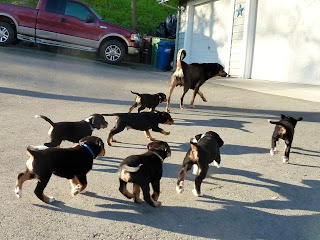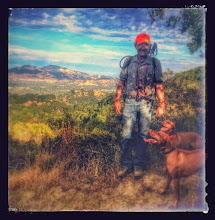Transylvanian Hounds
and Vizslas—Different but the Same
By Scott Maze-
Five years ago we acquired Hannah, a Transylvanian Hound puppy (in Hungarian, erdélyi kopó) purely by chance, just to save her from going to the pound. We already had one dog, but Hannah opened a whole new world for us. She led us to Puerto Rico, where she won her pedigree, to new friends and to Hungary and Transylvania, where her breed began.
Transylvanian Hounds share a common ancestry with Vizslas,
the two breeds probably diverging in the early Middle Ages. These dogs descended from the Asian hounds
accompanying the Magyars when they arrived in Transylvania in the 900’s. Those hounds mixed with local dogs and the
Celtic Hounds of the Romans. While
Vizslas developed along different lines, Kopós were used to hunt large game
such as bison, bear, deer, boar and lynx in the heavily forested slopes of the
Carpathian Mountains that ring Transylvania on three sides. Both breeds were pretty much the exclusive
property of the Hungarian nobility, who used them over the centuries for sport hunting
all over Transylvania. With only a small
number of owners, there must not have been many of these dogs even in the best
of times.
Kopós hunt in packs of no more than four, sent out alone to
flush the game and drive it back toward the hunters for the kill. Kopós have been known to cover as much as one
hundred miles in a single day during a hunt.
The hounds do not attack the game, they worry it into moving toward the
hunters instead of toward safety. Depending on the sounds made by their hounds,
hunters can tell the type and condition of the game coming toward them.
The good times for hunting began to end in 1918, the power
slipped away from the Hungarian nobles. After that
date, the popularity of hunting for sport must have declined and with it the
numbers of these dogs as well. Less than
twenty years later, World War II marked the final end of the good times for the
owners of both breeds. At the War’s end,
the arrival of the Russian Army in Transylvania meant the installation of a communist government, while Hungary suffered the same fate.
The Communists set about destroying all images of the power
and supremacy of the Hungarian ruling class.
That policy resulted in the 1947 edict that all Vizslas and Kopós were
to be eradicated (the official excuse was that they damaged crops and game). By the mid-1960’s, the few Kopós left in
Transylvania were hidden deep n the recesses of the Carpathians, while the few
Vizsla in the world had apparently been spirited out of the country years
earlier. From 1944 to 1968, no Kopó
puppies were recorded as being born (the few births were apparently kept
secret).
In the mid-1960’s, however, a few Kopós were smuggled out of
Transylvania by some intrepid Hungarians. With those few dogs, the Hungarians began a
revival that is still underway. And
since the fall of their Communist government in 1989, Transylvanians--both
ethnic Hungarians and Rumanians--have begun to slowly join in that revival.
Today, there are still less than one thousand Kopós left, with
a much smaller number of actual breed stock. But we are picking up the beat
here in the U.S. Worldwide last year,
about one hundred Kopó puppies were registered for pedigree with the FCI, all
of them born in Hungary or Transylvania.
This year, twenty puppies have already been registered in the U.S. and
the prospects for 2014 are even better, with the number of breeders expected to
double.
Hannah and her Hungarian mate Avar (now a U.S. citizen) are
the parents of eight of those puppies, the first U.S. litter ever registered
for FCI pedigree and the start of our own breeding colony, called California
Transylvanians. We are working closely
with other breeders in the Transylvanian Hound Club to help with the revival of
this breed in a way that preserves its qualities, which have not changed in a millennium.
So, what makes Kopós worth saving? First, they are an ancient breed, virtually unknown
outside their native land and relatively unchanged in over a thousand years,
unlike so many breeds today. Second,
they are bred to hunt but they are very mellow.
They are still used today to hunt wild boar in Transylvania, but at home
they are warm, affectionate and easy-going.
A Kopó forms a strong personal attachment that does not change once
established. They learn quickly and excel at recognizing
patterns—a Kopó barks at the mailman the first time, but never after that. They are cautious—they don’t charge into a
fight—but they are courageous when the need arises. And they are simple, beautiful, clean-lined
animals with short coats who thrive in heat and cold.
Five years after Hannah’s arrival, we happily live and play
with a pack of four, including her mate and two eight-month old puppies from
her first litter, with more litters planned.
When people ask why we didn’t just save a “pound puppy”, we tell them we
are saving an entire breed!




















5 comments:
Descriptions of this breed usually mention Tall and Short Transylvanian Hounds, but Short hounds occur very rarely, only in Tall hound litters. Short hounds are a reddish color similar to a Vizsla. Fewer than a dozen are known to exist today.
ooooh they sound interesting! I had never heard of them, sounds like they may be a good fit. Thanks for sharing this, love learning about new breeds.
anna
www.akginspiration.com
What an interesting post. These hounds sound like amazing dogs. I'm glad you've stepped up to help save them. :-)
Your story is not true because you say it as an hungarian would. This is a romanian breed, called "copoi ardelenesc" and this breed is born and was breed by romanians in Ardeal. The hungarians present this false story as they are the ones that registered this breed at the FCI but the best lines are still in Ardeal (Romania). The hungarians conquered Ardeal and killed a lot of romanian natives, took even their dogs and banned them from hunting and owing a gun dog. This is why they say it's an hungarian breed. In fact, copoiul ardelenesc is related to a whole line of "copoi" from Slovacia, Bulgaria, Serbia, Croatia, countries that were not part of the hungarian empire and that had this breed long before the hungarians came from Mongolia. So you are missinformed and if you want to see the real copoi ardelenesc, come to Ardeal, a lend in the middle of Transilvania amd also the middle of Romania, a romanian land. This is a roumanian breed and you would be surprised to see that it's a really popular breed that was never in danger to become extinct. Or it was in Hungary, not in its origin country, Romania.
Zoltan,
Thanks for posting. Love to see more pictures of the Translyvanian Hound in his native country. Find history of Central Europe very interesting!
Post a Comment